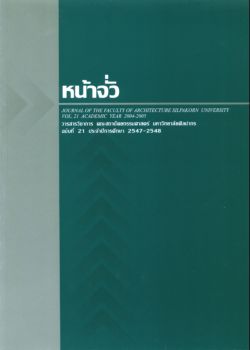An Energy Conscious Architectural Design: The Solar Responsive Envelope and Form Finding Approach
คำสำคัญ:
Buildable Volume, Shading Condition Volume, Solar Envelope Volume, Solar Insolationบทคัดย่อ
From the world energy crisis in 1973 to present global warming, there is a growing emphasis on integratingenergy-efficient strategies in architectural designing to reduce fossil fuel consumption and it's associated environmental pollution. In large part, the lack of effort by mainstream designers is due to the complexity in building's energy conscious concepts and the difficulty to visualize or quantify energy consumption. Conventionally, this task would be conveyed to the building system's engineer, normally delaying project after the basic architectural concepts have been completed. It is the assumption that the lack of tools to characterize the beneficial or detrimental characteristics associated with site energy resources during the preliminary design phase makes efforts to reduce a building's energy consumption more difficult. An effective simple tool and method should be available to assist architects at the beginning of the design stage.
The sun plays a major role in the design of human dwelling, requiring appropriate responses for ventilation, cooling, heating, and lighting. Architecture should be influenced by the relationship of the sun and building configuration. The full spectrum of solar radiation provides light and heat to the envelope of buildings. This solar radiation and its attendant luminance have a direct effect on the amount of energy a building will consume. If an architect can define, or map, the intensity of solar energy on the potential building site, and use this information to characterize the levels of solar insolation available to be accepted or rejected into the building, a more energy efficient envelope or form of the building can be established.
This paper will discuss an approach to develop a potential three-dimensional architectural form based on an insolation map related to the design site. The proposed computer-based programming procedure will be referred as Solar Effective Envelope Design Advisor (SEEDA). The three-dimensional form is determined by integrating three types of computer-generated models. These models are the Solar Envelope Volume model based on Prof. Ralph Knowles's principles and related research, the Buildahle Volume model based on design constraints, which will represent an optimum volume for the building; and the Shading Condition Volume model based on shade producing objects that surround the adjacent site. Once the integrated three-dimensional volume is created, the levels of insolation and luminance at the volume's surface can then be determined and quantified, hence, the solar responsive envelope and effective form will be defined.




